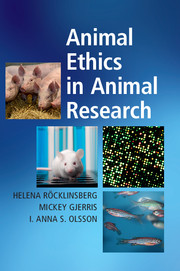Refine search
Actions for selected content:
168394 results for Perfusion Fixation of Research Animals
Alternatives to animal use in research: workshop on isolated perfused organs
-
- Journal:
- Animal Welfare / Volume 9 / Issue 3 / August 2000
- Published online by Cambridge University Press:
- 11 January 2023, p. 323
-
- Article
- Export citation
-
Research Directions
- Collection
9 - Using diffusion-perfusion MRI in animal models for drug development
-
-
- Book:
- Magnetic Resonance Imaging in Stroke
- Published online:
- 26 August 2009
- Print publication:
- 20 March 2003, pp 113-120
-
- Chapter
- Export citation
A Contribution to the Study of the Complement Fixation Reaction in Tuberculous Animals
-
- Journal:
- Journal of Hygiene / Volume 14 / Issue 1 / April 1914
- Published online by Cambridge University Press:
- 15 May 2009, pp. 52-71
-
- Article
-
- You have access
- Export citation
5 - Animal Research
-
- Book:
- Science and Ethics
- Published online:
- 15 December 2009
- Print publication:
- 27 March 2006, pp 99-128
-
- Chapter
- Export citation
Animal Research that Respects Animal Rights: Extending Requirements for Research with Humans to Animals
-
- Journal:
- Cambridge Quarterly of Healthcare Ethics / Volume 31 / Issue 1 / January 2022
- Published online by Cambridge University Press:
- 20 January 2022, pp. 59-72
-
- Article
-
- You have access
- Open access
- HTML
- Export citation

Animal Ethics in Animal Research
-
- Published online:
- 19 October 2017
- Print publication:
- 26 October 2017
Animals used in research
-
- Journal:
- Animal Welfare / Volume 1 / Issue 2 / May 1992
- Published online by Cambridge University Press:
- 11 January 2023, pp. 139-140
-
- Article
- Export citation
6 - Perfusion
-
-
- Book:
- Molecular Imaging
- Published online:
- 22 November 2017
- Print publication:
- 16 November 2017, pp 28-31
-
- Chapter
- Export citation
Animals in medical research
-
- Journal:
- Animal Welfare / Volume 2 / Issue 4 / November 1993
- Published online by Cambridge University Press:
- 11 January 2023, p. 365
-
- Article
- Export citation
Farm animals in research
-
- Journal:
- Animal Welfare / Volume 5 / Issue 3 / August 1996
- Published online by Cambridge University Press:
- 11 January 2023, p. 314
-
- Article
- Export citation
Chapter 11 - Animal Research and Alternatives
-
-
- Book:
- Introduction to Research Methodology for Specialists and Trainees
- Published online:
- 04 August 2017
- Print publication:
- 17 August 2017, pp 83-87
-
- Chapter
- Export citation
Use of animals in research
-
- Journal:
- Animal Welfare / Volume 4 / Issue 4 / November 1995
- Published online by Cambridge University Press:
- 11 January 2023, p. 375
-
- Article
- Export citation
Use of animals in research
-
- Journal:
- Animal Welfare / Volume 1 / Issue 1 / February 1992
- Published online by Cambridge University Press:
- 11 January 2023, p. 65
-
- Article
- Export citation
Practical farm animal research
-
- Journal:
- Animal Welfare / Volume 7 / Issue 1 / February 1998
- Published online by Cambridge University Press:
- 11 January 2023, pp. 101-102
-
- Article
- Export citation
1 - Guidelines for the use of animals in research
-
- Book:
- Measuring Behaviour
- Published online:
- 05 June 2012
- Print publication:
- 22 April 1993, pp 161-167
-
- Chapter
- Export citation
The Ethical Challenges of Animal Research: Honoring Henry Beecher’s Approach to Moral Problems
-
- Journal:
- Cambridge Quarterly of Healthcare Ethics / Volume 24 / Issue 4 / October 2015
- Published online by Cambridge University Press:
- 14 September 2015, pp. 391-406
-
- Article
- Export citation
The ethics of research involving animals
-
- Journal:
- Animal Welfare / Volume 14 / Issue 4 / November 2005
- Published online by Cambridge University Press:
- 11 January 2023, pp. 385-386
-
- Article
- Export citation
Student booklets on animal research
-
- Journal:
- Animal Welfare / Volume 2 / Issue 2 / May 1993
- Published online by Cambridge University Press:
- 11 January 2023, pp. 176-177
-
- Article
- Export citation
Research animal well-being
-
- Journal:
- Animal Welfare / Volume 2 / Issue 3 / August 1993
- Published online by Cambridge University Press:
- 11 January 2023, p. 279
-
- Article
- Export citation
